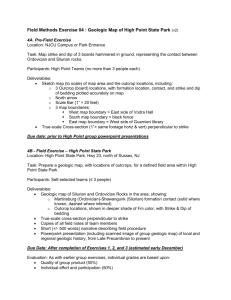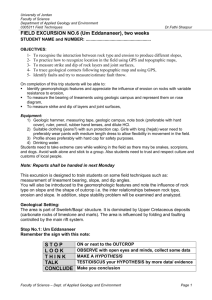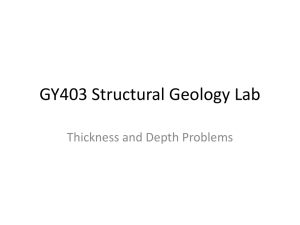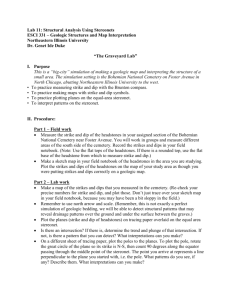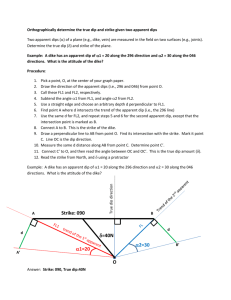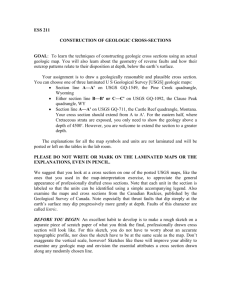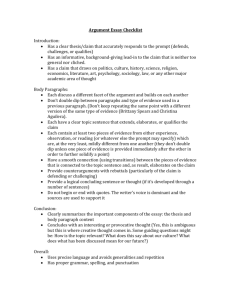geos.204.maps
advertisement
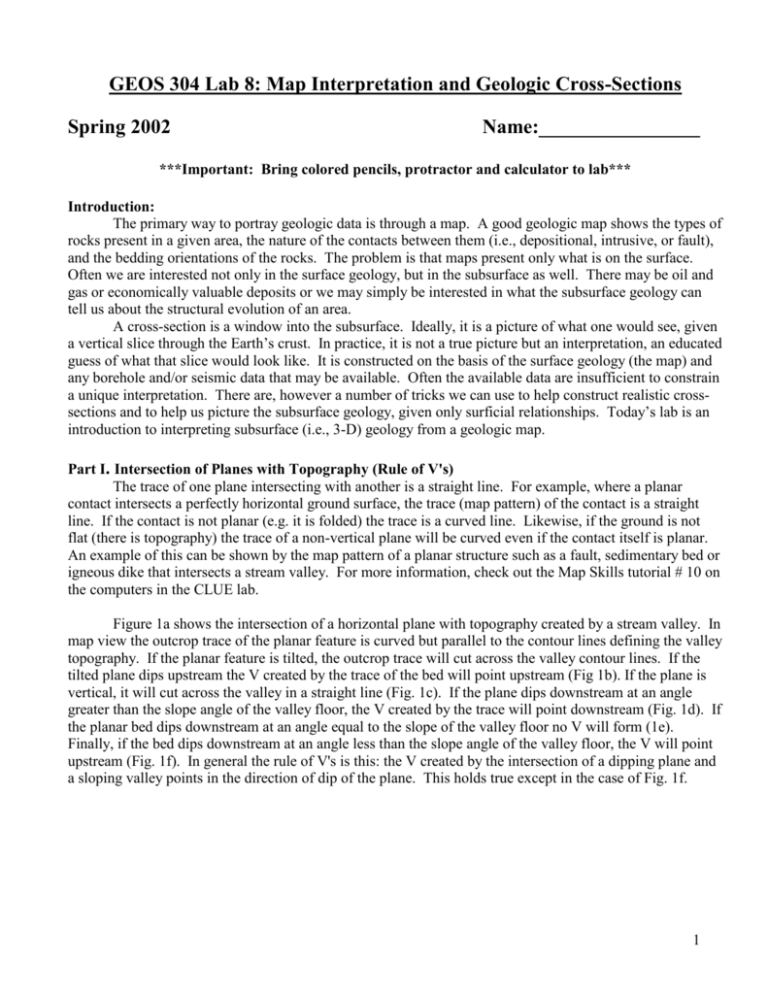
GEOS 304 Lab 8: Map Interpretation and Geologic Cross-Sections Spring 2002 Name:________________ ***Important: Bring colored pencils, protractor and calculator to lab*** Introduction: The primary way to portray geologic data is through a map. A good geologic map shows the types of rocks present in a given area, the nature of the contacts between them (i.e., depositional, intrusive, or fault), and the bedding orientations of the rocks. The problem is that maps present only what is on the surface. Often we are interested not only in the surface geology, but in the subsurface as well. There may be oil and gas or economically valuable deposits or we may simply be interested in what the subsurface geology can tell us about the structural evolution of an area. A cross-section is a window into the subsurface. Ideally, it is a picture of what one would see, given a vertical slice through the Earth’s crust. In practice, it is not a true picture but an interpretation, an educated guess of what that slice would look like. It is constructed on the basis of the surface geology (the map) and any borehole and/or seismic data that may be available. Often the available data are insufficient to constrain a unique interpretation. There are, however a number of tricks we can use to help construct realistic crosssections and to help us picture the subsurface geology, given only surficial relationships. Today’s lab is an introduction to interpreting subsurface (i.e., 3-D) geology from a geologic map. Part I. Intersection of Planes with Topography (Rule of V's) The trace of one plane intersecting with another is a straight line. For example, where a planar contact intersects a perfectly horizontal ground surface, the trace (map pattern) of the contact is a straight line. If the contact is not planar (e.g. it is folded) the trace is a curved line. Likewise, if the ground is not flat (there is topography) the trace of a non-vertical plane will be curved even if the contact itself is planar. An example of this can be shown by the map pattern of a planar structure such as a fault, sedimentary bed or igneous dike that intersects a stream valley. For more information, check out the Map Skills tutorial # 10 on the computers in the CLUE lab. Figure 1a shows the intersection of a horizontal plane with topography created by a stream valley. In map view the outcrop trace of the planar feature is curved but parallel to the contour lines defining the valley topography. If the planar feature is tilted, the outcrop trace will cut across the valley contour lines. If the tilted plane dips upstream the V created by the trace of the bed will point upstream (Fig 1b). If the plane is vertical, it will cut across the valley in a straight line (Fig. 1c). If the plane dips downstream at an angle greater than the slope angle of the valley floor, the V created by the trace will point downstream (Fig. 1d). If the planar bed dips downstream at an angle equal to the slope of the valley floor no V will form (1e). Finally, if the bed dips downstream at an angle less than the slope angle of the valley floor, the V will point upstream (Fig. 1f). In general the rule of V's is this: the V created by the intersection of a dipping plane and a sloping valley points in the direction of dip of the plane. This holds true except in the case of Fig. 1f. 1 Figure 1. Outcrop patterns illustrating the rule of V's 2 1. (10 pts) It is often useful to determine the strike and dip of bedding or a fault by the outcrop pattern. This can be done using the intersection of the surface (top or bottom of the bed) at three different elevations (i.e. 3-point problem, p. 690-691 of Davis & Reynolds). Use the 3-point technique to determine the strike and dip of the bed shown in the two figures below. The topography is identical in each figure but the orientation of the bedding is different. Use any two points at the same elevation with a third point (at a different elevation) to check your answer. B B C A C A Part II: Apparent thickness and apparent dip calculations A. Apparent Thickness Knowledge of bedding thickness is essential for the development of geologic cross-sections. The width of a stratigraphic unit exposed at the surface is usually quite different from the true bedding thickness because dipping beds are often planed off horizontally through erosion. Their width at the surface is then an apparent thickness rather than the true bedding thickness. However with a little trigonometry, surface measurements of bedding strike, dip, exposed surface width, and topographic slope angle can be used to determine bedding thickness. 3 Terms: Horizontal width (W): The horizontal distance measured across a stratigraphic unit along a line perpendicular to strike. Ground distance (d): The exposed surface width of a stratigraphic unit measured perpendicular to strike. Bed thickness (t): Bedding thickness measured (or calculated) along a line perpendicular to the plane of bedding (i.e. perpendicular to the upper and lower contacts of the unit. Dip angle (): The true dip of bedding as measured perpendicular to strike. Expressed in degrees down from horizontal. Slope angle (): The angle (in degrees) between the topographic slope and horizontal measured in the vertical plane. Angle is positive when topographic slope dips in the same direction as the stratigraphic unit. Outcrop Width: The horizontal distance measured across a stratigraphic unit along a line perpendicular to strike. Thickness: The distance measured or calculated along a line that is perpendicular to the plane of bedding (i.e., perpendicular to the plane containing strike and dip). Fig. 1: Variation of outcrop width with respect to dip and thickness (width decreases as thickness and/or dip increases). Fig. 2: The relationship between width (w), thickness (t) and dip angle () t = w sin (-) Fig 3: Apparent thickness (at) and apparent width (aw) will be determined if the unit is not measured perpendicular to strike 4 2. (4 pts) w = 20 m dip=30 What is the true thickness of the unit? 3. (4 pts) w = 35 m dip = 40 The width is measured on a slope of 25° in the same direction as the dip of bedding. What is t? t= B. Apparent Dip: If a cross-section is constructed perpendicular to the strike of bedding, the dip of beds in the cross section will be the same as the dip measured in 3-D. Usually, however, not all bedding strikes are perpendicular to the line of the cross-section. In these cases, bedding on the cross-section will appear to dip at an angle less than the true dip. Since the solution of strike and dip problems involves a series of right triangles, it is clear that solutions can also be obtained trigonometrically. The relationship linking true dip (), apparent dip (a), and the angle between the strike and the direction in which apparent dip is measured () is: tan a = tan sin There are several varieties of graphical and mechanical aids, based largely on the trigonometric relationships, for finding apparent dip. 4. (4 pts) The attitude of a bedding plane is N55°E, 45°S. Find the apparent dip of the bed in a vertical section striking N50°W (use the formula given and show your work). 5. (4 pts) The strike of bedding is 340° and the dip is 75° NE. What are the apparent dips in the directions of due North and N30°E? 5 III: Application Famous U.S.G.S. geologist Melvin Mudge produced a geologic map and cross section of an area of western Montana, south of Glacier National Park. A large amount of data is represented in his map and cross section. Even though we have not visited his map area, we will be able to draw numerous conclusions about the geology of this part of Montana based exclusively from his map and cross section. 6. (4 pts) Why did Mel choose to draw his cross section along a line oriented ENE-WSW? Think about it this way - how many structures would show up on a cross section oriented NNW-SSE? Which cross section would tell you more about the geologic structure of the area ? 7. (4pts) It is possible to tell relative dips of faults using only map patterns. Which fault dips more steeply, the Glenn Fault or the Renshaw Thrust? Explain how this is obtainable from the map. 8. (10 pts) Large faults have greater stratigraphic offset than smaller faults. For example, a fault that places Mississippian rocks against Pennsylvanian rocks has less stratigraphic offset than a fault placing Cambrian rocks on Jurassic rocks, and thus probably experienced less slip. Describe the stratigraphic offset (give the names of the 2 juxtaposed units - their age and formation name) for the Renshaw Thrust (3 points) and for the South Fork Thrust Zone (3 points). Now, more importantly, explain which fault probably experienced more slip (4 points). 9. (4pts) On his map the Aamzing Mel hasn't recorded the strike and dip for even a single fault, yet he needed that information to draw his cross section. How did he get it? Hint: Look back at page 3. 10. (4pts) One of the basic assumptions in drawing cross sections is the rock is neither created nor destroyed; in other words, the volume of rock remains constant. In terms of drawing a cross section, this means that depositional bed thickness doesn't vary within any given unit. Now look at Mc on the cross section. Bed thickness is definitely not constant. Why not? There are actually two reasons, neither of which is that Mel is an idiot. 6 Part IV: Geologic Cross-sections Hints on construction: Often the best way to visualize a structure on a geologic map is with a vertical cross-section. Check out the software Visualizing Geology in 3-D tutorial on Cross-sections. The following exercises focus on the interpretation of geologic maps through the construction of geologic cross-sections. In order to successfully construct geologic cross-sections it will be helpful to consider the following suggestions: A. Examine the legend and study the stratigraphic sequence (relative ages of formations, volcanic rocks, plutonic rocks). B. Study the map. Identify the major (map-scale) structures, like anticlines, synclines, thrust faults and normal faults. Determine their structural trend. C. Transfer the topographic profile of the cross-section to graph paper. Note the scale. D. Mark the contacts between formation along the top of your profile (including faults etc.) E. Transfer pertinent geologic information from the vicinity of the cross-section onto your profile. Include location of fold axes, locations of faults and fault types and most importantly dip values. Be careful when transferring dip values to correct for apparent dip! The cross-section may not be perpendicular to the strike! F. At the scale of the maps you will be working with formation thicknesses that "presumably" remain constant. In other words be careful not to "create" or "destroy" rock. One way to determine the thickness of formations is to project the contacts between formations (using the dip values from the map) a short distance to depth, keeping the dip constant. Transfer the thickness of each formation (in stratigraphic sequence) onto the edge of an index card or something similar. It will help you to keep the formations at constant thickness. Note: The only time you may change the thickness of formations is if there is good indication of internal deformation. For example a shale or limestone with inherent planar weakness along bedding planes may have been thickened under compression by internal thrusting. G. Once you have established the thickness of the stratigraphic sequence you may begin to construct your cross-section by extending the contacts between formations to depth. Usually geologic (natural) features are neither straight lines nor perfect arcs. Look at other cross-sections to get a feel for what structures look like in 3 dimensions. Your cross-section should be guided by simplicity and should be "geologically reasonable". In other words: don't make things more complicated than they need to be. Sometimes it may be helpful to sketch things on a different sheet of paper to see if they make sense. H. If your map shows discontinuities in the stratigraphic sequence (gaps or repetitions) they are usually a good indication of faulting. Thrust faults cause repetitions and normal faults cause gaps in the stratigraphic sequence. Thrust faults place older rocks on younger rocks. Normal faults place younger rocks on older rocks. I. Try to draw your cross-section as deep as possible without inventing structures. There should always be a reason why you draw things the way you do. 7 11. (25 pts) Make a vertical cross section from C - D on the Wildwood Quadrangle, Tennessee. Use the topographic profile provided below and refer to the instructions on the last page or ask your instructor. 8 Bonus #2 (15 pts) Construct a cross-section for the Duffield Quadrangle along the line running NW-SE across the map (see TA for a copy). Your cross-section should cover the entire length of that line and should extend deep enough to show where the maps units go in the subsurface (~5000 ft). You will need to construct your own topographic profile for this one. The key is to make sure that the vertical scale on your profile matches the horizontal scale (for reference, 1 inch on the map is 2000 ft). Consult the appendix in Davis and Reynolds (p. 678-673) on how to do this and for general cross-section drawing tips. Feel free to consult with us as well. Good luck! 9 10
